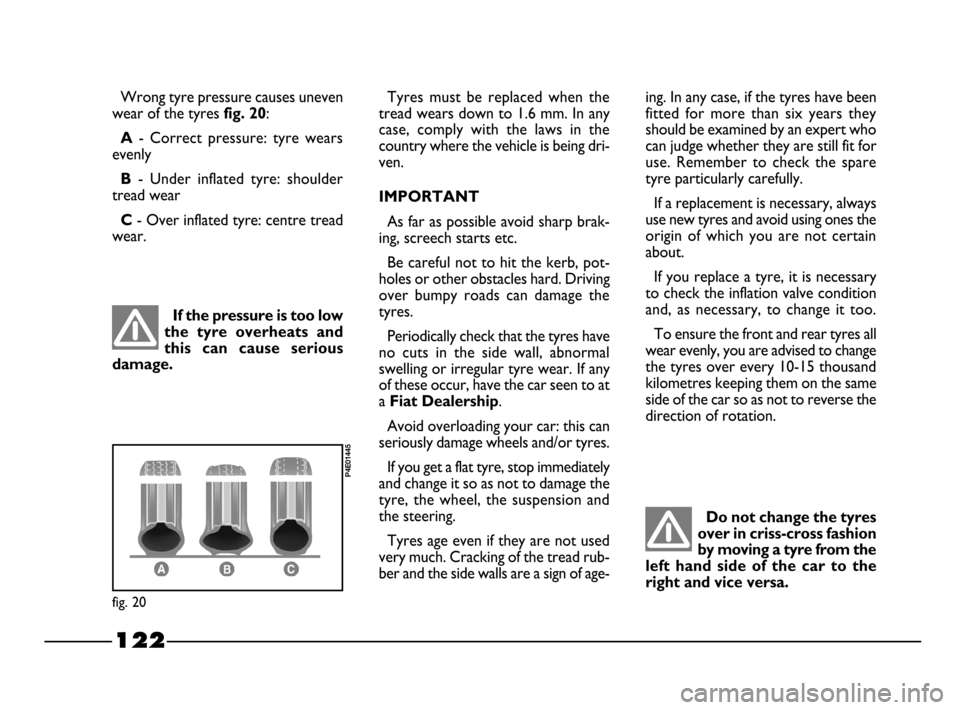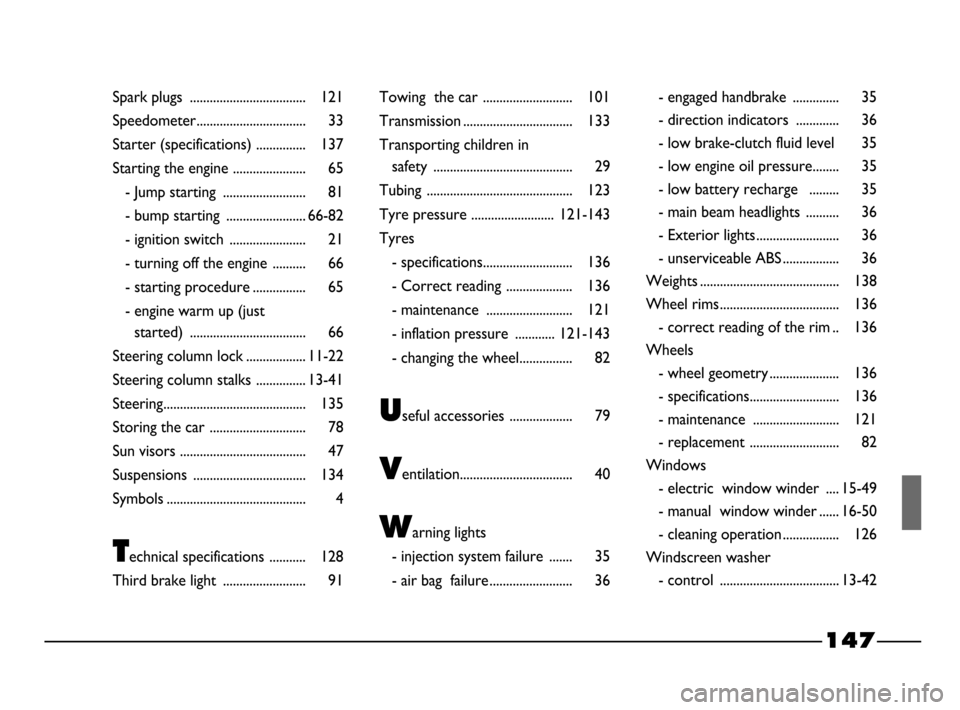suspension FIAT PALIO 2003 178 / 1.G India Version Owners Manual
[x] Cancel search | Manufacturer: FIAT, Model Year: 2003, Model line: PALIO, Model: FIAT PALIO 2003 178 / 1.GPages: 156, PDF Size: 6.27 MB
Page 123 of 156

122
Do not change the tyres
over in criss-cross fashion
by moving a tyre from the
left hand side of the car to the
right and vice versa.
Wrong tyre pressure causes uneven
wear of the tyres
fig. 20:
A- Correct pressure: tyre wears
evenly
B- Under inflated tyre: shoulder
tread wear
C- Over inflated tyre: centre tread
wear. Tyres must be replaced when the
tread wears down to 1.6 mm. In any
case, comply with the laws in the
country where the vehicle is being dri-
ven.
IMPORTANT
As far as possible avoid sharp brak-
ing, screech starts etc.
Be careful not to hit the kerb, pot-
holes or other obstacles hard. Driving
over bumpy roads can damage the
tyres.
Periodically check that the tyres have
no cuts in the side wall, abnormal
swelling or irregular tyre wear. If any
of these occur, have the car seen to at
a
Fiat Dealership.
Avoid overloading your car: this can
seriously damage wheels and/or tyres.
If you get a flat tyre, stop immediately
and change it so as not to damage the
tyre, the wheel, the suspension and
the steering.
Tyres age even if they are not used
very much. Cracking of the tread rub-
ber and the side walls are a sign of age-
If the pressure is too low
the tyre overheats and
this can cause serious
damage.
fig. 20
P4E01445
ing. In any case, if the tyres have been
fitted for more than six years they
should be examined by an expert who
can judge whether they are still fit for
use. Remember to check the spare
tyre particularly carefully.
If a replacement is necessary, always
use new tyres and avoid using ones the
origin of which you are not certain
about.
If you replace a tyre, it is necessary
to check the inflation valve condition
and, as necessary, to change it too.
To ensure the front and rear tyres all
wear evenly, you are advised to change
the tyres over every 10-15 thousand
kilometres keeping them on the same
side of the car so as not to reverse the
direction of rotation.
104-127 03/03/2003 06:53 PM Page 122
Page 129 of 156

TECHNICAL SPECIFICATIONS
Motor and engineering enthusiasts as well as
those “in the trade” will probably start reading from
this point in the handbook. This, in fact, is where a
section jam-packed with facts, figures, formulae,
measurements and tables begins.
In a sense, it is Fiat Palio’s identity card. A docu-
ment that introduces the car and explains in techni-
cal jargon all the features that go together to make it
a model designed to give you superlative driving sat-
isfaction.CAR IDENTIFICATION DATA ........................... PAGE 129
ENGINE CODES -
BODYWORK PAINT IDENTIFICATION
PLATE .......................................................................... PAGE 130
ENGINE ....................................................................... PAGE 131
TRANSMISSION ....................................................... PAGE 133
BRAKES ....................................................................... PAGE 134
SUSPENSIONS ......................................................... PAGE. 134
STEERING ................................................................... PAGE 135
WHEELS AND TYRES ............................................ PAGE 136
ELECTRICAL SYSTEM ............................................ PAGE 137
WEIGHTS ................................................................... PAGE 138
PERFORMANCES ..................................................... PAGE 138
DIMENSIONS ............................................................ PAGE 139
CAPACITIES .............................................................. PAGE 140
FLUIDS AND LUBRICANTS ................................. PAGE 141
TYRE PRESSURE ....................................................... PAGE 143
128
128-143 03/03/2003 07:39 PM Page 128
Page 135 of 156

134
SUSPENSIONS
FRONT
Independent wheel, MacPherson-
type with lower wishbones anchored
to an auxiliary cross bar.
Coil springs and double action shock
absorbers.
Anti-roll stabiliser bar.
REAR
Torsion axle coil spring.
Stabiliser bar and telescopic dual ef-
fect shock absorber.
BRAKES
SERVICE AND EMERGENCY
BRAKES
Front: disc-type with floating calliper.
Rear: drum and self-centering shoes.
Cross-over hydraulic circuit control.
Vacuum brake booster: 9”.
Four channel ABS system with four
sensors.
Automatic take-up of clearance due
to friction lining wear.
Brake distributor proportioning valve
working on the hydraulic cricuit of the
rear brakes.
HAND BRAKE
Controlled by a lever, it works me-
chanically on the rear brakes.
128-143 03/03/2003 07:39 PM Page 134
Page 148 of 156

147
Spark plugs ................................... 121
Speedometer................................. 33
Starter (specifications) ............... 137
Starting the engine ...................... 65
- Jump starting ......................... 81
- bump starting ........................ 66-82
- ignition switch ....................... 21
- turning off the engine .......... 66
- starting procedure ................ 65
- engine warm up (just
started) ................................... 66
Steering column lock .................. 11-22
Steering column stalks ............... 13-41
Steering........................................... 135
Storing the car ............................. 78
Sun visors ...................................... 47
Suspensions .................................. 134
Symbols .......................................... 4
Technical specifications ........... 128
Third brake light ......................... 91Towing the car ........................... 101
Transmission ................................. 133
Transporting children in
safety .......................................... 29
Tubing ............................................ 123
Tyre pressure ......................... 121-143
Tyres
- specifications........................... 136
- Correct reading .................... 136
- maintenance .......................... 121
- inflation pressure ............ 121-143
- changing the wheel................ 82
Useful accessories ................... 79
Ventilation.................................. 40
Warning lights
- injection system failure ....... 35
- air bag failure ......................... 36- engaged handbrake .............. 35
- direction indicators ............. 36
- low brake-clutch fluid level 35
- low engine oil pressure........ 35
- low battery recharge ......... 35
- main beam headlights .......... 36
- Exterior lights ......................... 36
- unserviceable ABS ................. 36
Weights .......................................... 138
Wheel rims.................................... 136
- correct reading of the rim .. 136
Wheels
- wheel geometry ..................... 136
- specifications........................... 136
- maintenance .......................... 121
- replacement ........................... 82
Windows
- electric window winder .... 15-49
- manual window winder ...... 16-50
- cleaning operation ................. 126
Windscreen washer
- control .................................... 13-42
144-152 03/03/2003 07:30 PM Page 147